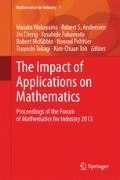Abstract
The convex feasibility problem asks to find a point in the intersection of a collection of nonempty closed convex sets. This problem is of basic importance in mathematics and the physical sciences, and projection (or splitting) methods solve it by employing the projection operators associated with the individual sets to generate a sequence which converges to a solution. Motivated by an application in road design, we present the method of cyclic intrepid projections (CycIP) and provide a rigorous convergence analysis. We also report on very promising numerical experiments in which CycIP is compared to a commerical state-of-the-art optimization solver.
Access this chapter
Tax calculation will be finalised at checkout
Purchases are for personal use only
Notes
- 1.
Given a nonempty subset \(S\) of \(X\) and \(x\in X\), we write \(d_S(x) := \inf _{s\in S}\Vert x-s\Vert \) for the distance from \(x\) to \(S\). If \(S\) is also closed and convex, then the infimum defining \(d_S(x)\) is attained at a unique vector called the projection of \(x\) onto \(S\) and denoted by \(P_S(x)\) or \(P_Sx\).
- 2.
This function is considered, e.g., in [7, Exercise 8.5].
- 3.
In [5], the authors compared CycIP with a Swiss Army Knife. The Wenger Swiss Army Knife version XXL, listed in the Guinness Book of World Records as the world’s most multi-functional penknife, contains 87 tools.
- 4.
Recall that if \(x=(\xi _1,\ldots ,\xi _n)\in X\), then \(\Vert x\Vert _\infty = \max \{|\xi _1|,\ldots ,|\xi _n|\}\).
- 5.
For further information on performance profiles, we refer the reader to [14].
- 6.
Recall that if \(x=(\xi _1,\ldots ,\xi _n)\in X\), then \(\Vert x\Vert _1 = |\xi _1|+\cdots +|\xi _n|\).
- 7.
To allow for a more fair comparison, we included in wall-clock time only the time required for running the solver’s software itself (and not the time for loading the problem data or for setting up the solver’s parameters).
References
Baillon, J.B., Bruck, R.E., Reich, S.: On the asymptotic behavior of nonexpansive mappings and semigroups in Banach spaces. Houston J. Math. 4, 1–9 (1978)
Bauschke, H.H., Borwein, J.M.: On projection algorithms for solving convex feasibility problems. SIAM Rev. 38, 367–426 (1996)
Bauschke, H.H., Combettes, P.L.: A weak-to-strong convergence principle for Fejér-monotone methods in Hilbert spaces. Math. Oper. Res. 26, 248–264 (2001)
Bauschke, H.H., Combettes, P.L.: Convex analysis and monotone operator theory in Hilbert spaces. Springer, New York (2011)
Bauschke, H.H., Koch, V.R.: Projection methods: swiss army knives for solving feasibility and best approximation problems with halfspaces. Contemporary Mathematics (in press)
Borwein, J.M., Vanderwerff, J.D.: Convex functions. Cambridge University Press, Cambridge (2010)
Boyd, S., Vandenberghe, L.: Convex optimization. Cambridge University Press, Cambridge (2004)
Cegielski, A.: Iterative methods for fixed point problems in Hilbert spaces. Springer, New York (2012)
Censor, Y., Zenios, S.A.: Parallel Optimization. Oxford University Press, Oxford (1997)
Chen, W., Herman, G.T.: Efficient controls for finitely convergent sequential al gorithms. ACM Trans. Math. Software 37, 14 (2010)
Combettes, P.L.: Hilbertian convex feasibility problems: convergence of projection methods. Appl. Math. Optim. 35, 311–330 (1997)
Combettes, P.L.: Inherently parallel algorithms in feasibility and optimization and their applications. In: Butnariu, D., Censor, Y., Reich, S. (eds.) Quasi-Fejérian analysis of some optimization algorithms, pp. 115–152. Elsevier, New York (2001)
Combettes, P.L.: Solving monotone inclusions via compositions of nonexpansive averaged operators. Optimization 53, 475–504 (2004)
Dolan, E.D., Moré, J.J.: Benchmarking optimization software with performance profiles. Math. Program. (Ser. A) 91, 201–213 (2002)
Goebel, K., Kirk, W.A.: Topics in metric fixed point theory. Cambridge University Press, Cambridge (1990)
Goebel, K., Reich, S.: Uniform convexity, hyperbolic geometry, and nonexpansive mappings. Marcel Dekker, New York (1984)
Gurobi optimization Inc: gurobi optimizer reference manual. http://www.gurobi.com, (2013)
Herman, G.T.: A relaxation method for reconstructing objects from noisy x-rays. Math. Program. 8, 1–19 (1975)
Herman, G.T.: Fundamentals of computerized tomography: image reconstruction from projections, 2nd edn. Springer, New York (2009)
Hundal, H.: An alternating projection that does not converge in norm. Nonlinear Anal. 57, 35–61 (2004)
Rockafellar, R.T., Wets, R.J.-B.: Variational analysis. Springer-Verlag, New York (1998)
Slavakis, K., Yamada, I.: The adaptive projected subgradient method constrained by families of quasi-nonexpansive mappings and its applicaton to online learning. SIAM J. Optim. 23, 126–152 (2013)
Yamada, I., Ogura, N.: Hybrid steepest descent method for variational inequality problem over the fixed point set of certain quasi-nonexpansive mappings. Numer. Funct. Anal. Optim. 25, 619–655 (2004)
Yamada, I., Yukawa, M., Yamagishi, M.: Minimizing the moreau envelope of nonsmooth convex functions over the fixed point set of certain quasi-nonexpansive mappings. In: Bauschke, H.H., Burachik, R.S., Combettes, P.L., Elser, V., Luke, D.R., Wolkowicz, H. (eds.) Fixed-point algorithms for inverse problems in science and engineering, springer optimization and its applications, pp. 345–390. Springer, New York (2011)
Acknowledgments
The authors thank the referee for very careful reading and constructive comments, Dr. Ramon Lawrence for the opportunity to run the numerical experiments on his server, and Scott Fazackerley and Wade Klaver for technical help. HHB also thanks Dr. Masato Wakayama and the Institute of Mathematics for Industry, Kyushu University, Fukuoka, Japan for their hospitality —some of this research benefited from the extremely stimulating environment during the “Math-for-Industry 2013” forum. HHB was partially supported by the Natural Sciences and Engineering Research Council of Canada (Discovery Grant and Accelerator Supplement) and by the Canada Research Chair Program.
Author information
Authors and Affiliations
Corresponding author
Editor information
Editors and Affiliations
Rights and permissions
Copyright information
© 2014 Springer Japan
About this paper
Cite this paper
Bauschke, H.H., Iorio, F., Koch, V.R. (2014). The Method of Cyclic Intrepid Projections: Convergence Analysis and Numerical Experiments. In: Wakayama, M., et al. The Impact of Applications on Mathematics. Mathematics for Industry, vol 1. Springer, Tokyo. https://doi.org/10.1007/978-4-431-54907-9_14
Download citation
DOI: https://doi.org/10.1007/978-4-431-54907-9_14
Published:
Publisher Name: Springer, Tokyo
Print ISBN: 978-4-431-54906-2
Online ISBN: 978-4-431-54907-9
eBook Packages: EngineeringEngineering (R0)

